Gond Art and Culture: The Indigenous Aesthetics of Central India

India’s cultural landscape has various threads of traditions, spirituality and creativity that is said to be connected with the stories of tribal communities. Among these communities, the Gonds stand strong as an example of resilience, creativity and cultural richness. Comprising just over 9 million, out of the total tribal population of India, the Gonds represent a distinctive part of the country’s indigenous people. Within the community itself, resides a comparatively smaller community called the Gond Pradhans. Their population numbers about 20,000, these artisans inhabit the heartland of central India, in the region that is historically known as Gondwana. This land is steeped in folklore and ancient traditions which serves as the cradle of remarkable artistic legacy.
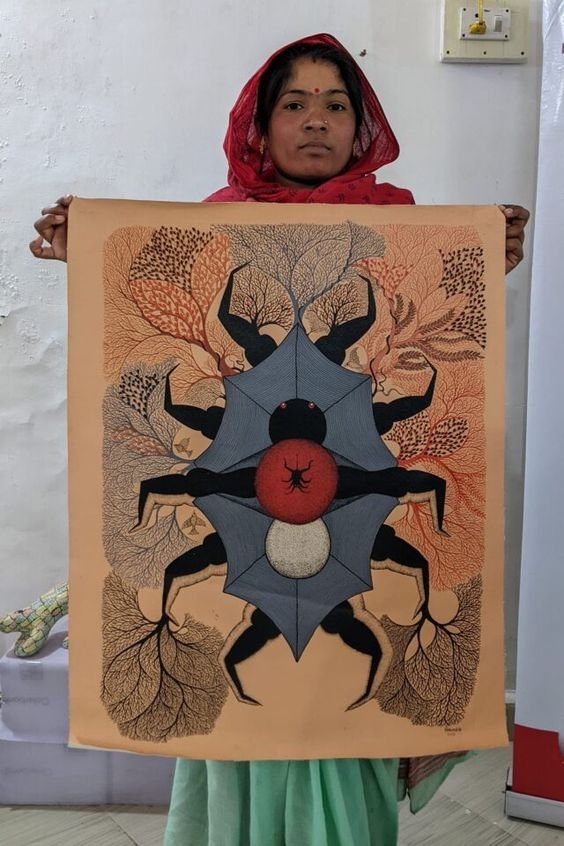
At the crossroad of time and traditions, a group of Gond artist have emerged, with the help of their brushes and pigments to breathe life into age-old tales and ancestral wisdom. Their artistry goes beyond mere aesthetics, it serves as a conduit for cultural preservation and stands as an example to the enduring spirit of its people. In their hands, cultural traditions from an indiscernible past find new expressions, that resonates across millennia through a contemporary art form that captures their unique identity. It is not just a visual feast, but a depiction of their way of life. It is rooted deeply in their spiritual beliefs, mythologies and connection to nature. With the help of vibrant colors and detailed patterns, Gond artist paint a canvas that mirrors their collective memory and individual experiences which invites viewers into a realm where tradition and innovation collides.
In the 1980s, a group of researchers, driven by passion for indigenous culture and artistic expressions, came across a remarkable find, a relief crafter by a young Pradhan Gond named Jangarh Singh Shyam. He was born in 1962, in the village of Patangarh. He possessed a natural talent that went beyond the ordinary. His unique design and colors spoke of a deep connection to his cultural heritage and the rich tapestry of Gond folklore. His creation had captivated the attention of an esteemed curator, J Swaminathan, which changed his course of life forever. Swaminathan, recognized the potential for greatness, and thus invited him to study painting and unleash the full extent of his artistic powers. Jangarh, left his village and went into the bustling city where he found himself immersed in a world of paper and canvas. He breathed life into his canvases, infusing them with the essence of his cultural roots and boundless creativity of his spirit.
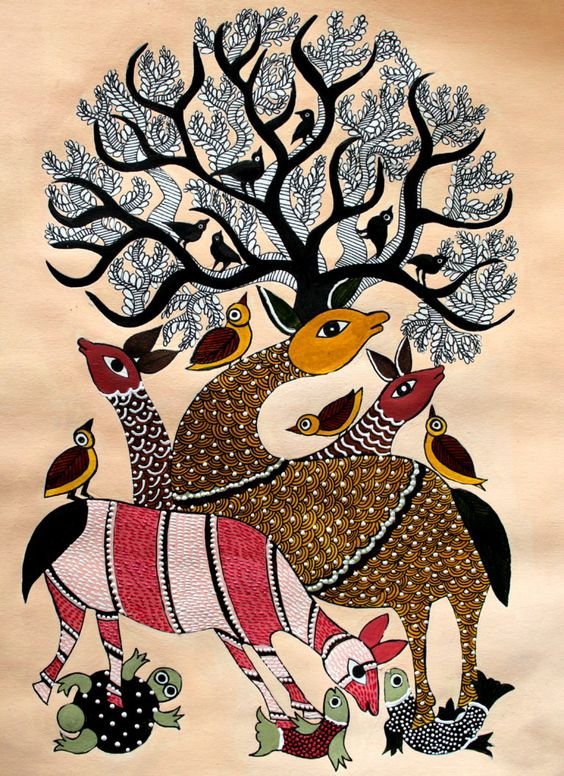
However, for Jangarh, true fulfillment did not just lay in his own artistic pursuits but also in sharing his knowledge and passion with others. Thus, alongside his career as a painter, he went on a noble mission, that was to nurture and inspire the next generations of Gond artist. Under his guidance, there were eager learners who delved into the rich tradition of Gond art. They learnt about the techniques and storytelling methods that were passed down through generations. With the help of his teaching, he ignited a spark of creativity in the hearts of his people, and igniting a renaissance of Gond artistry that would echo through the annals of history. Even today, his legacy is an example of the enduring power of art and resilience of the human spirit.
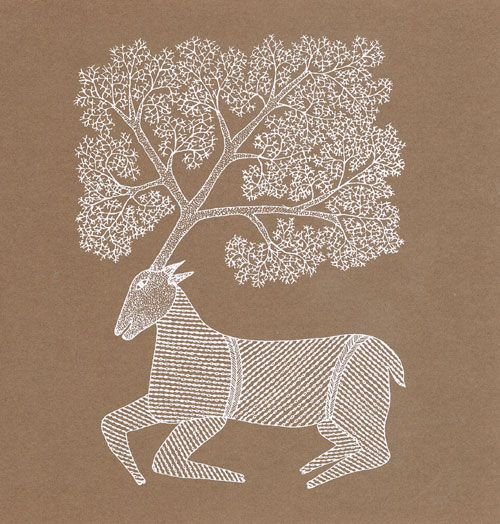
The region they live in, Gondwana, covers parts of present-day central and eastern India. The ruling class, RajGonds, endowed with authority and prestige. Across the landscape of Gondwana, four major kingdoms rose to prominence. One of them was the Chanda kingdom, which was established in 807 AD. It emerged as the preeminent seat of Gond power, and its influence stretched far wide across the land. Under their rule, the Gonds flourished. Their kings were visionaries, pioneering advancements in agriculture and infrastructure that changed the landscape of a Gondwana and led to prosperity.
However, along with prosperity came conflicts and conquests. Looking at the wealth and strategic importance of Gondwana, rival kingdoms wished to acquire their fertile lands. Among the legendary figures, Rani Durgavati was someone who showed her courage and defiance. She was renowned for her valor and indomitable spirit that led people into battle against the forces of Mughal Emperor Akbar. However, they were defeated and subjugated by the Mughals. The arrival of British marked a turning point in the fate of Gonds, they saw their ancestral lands stripped away, their access to forest restricted and their way of life threatened by the foreign rule.
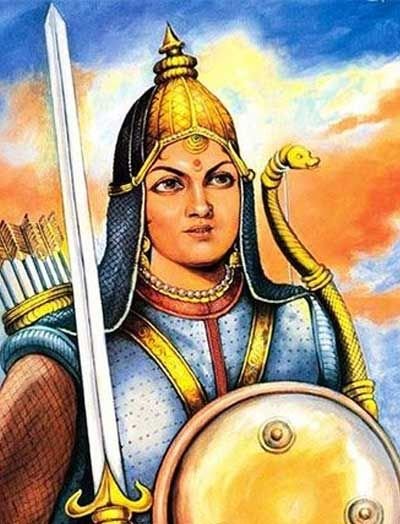
In 1910, the Gonds rebelled against the British, famously known as the Bastar Rebellion. They had a strong desire of freedom and justice within them, and thus challenged the hegemony of their colonial rule, demanding the restoration of their rights and autonomy. Despite their efforts, the rebellion was put down by British.
When the Gondwana region was flourishing, which was after the decline of Delhi Sultanate, the stronger and more influential tribes started asserting their dominance over the smaller tribes. They used the concept of decentralization in their administration, the smallest unit of governance was called Barhots. They served as the building blocks of the kingdom’s administrative structure, and ensured proper governance and fulfilled the local needs. Further, subdividing the Gahrs were administrative units known as Chaurasi. Each Chaurasi encompassed a number of villages, typically numbering 84, and each Barhot overseeing over 12 villages. This hierarchal structure helped in communication, coordination and decision-making at every level of society, allowing the Gond tribes to flourish in a landscape shaped by unity, resilience and shared purpose.

The Gond tribe is known for its artistic traditions as mentioned before, however, among their most renowned artistic achievements is the Gond style of painting. Their wall paintings adorn the surface of important structure within their community. These murals serve not only as the only way to express aesthetic beauty but also a way in which cultural heritage and communal identity are restored. Their striking composition which includes interplay of geometric patterns, stylized human figures and excellent depiction of nature’s beauty. Their paintings also find a way to express everyday objects, including tobacco cases and combs.
They even used to draw inspiration from their surroundings and the Mandala Gond artist used to infuse their paintings with vivid depictions of local flora and fauna. This captured the essence of their native habitats with excellent artistry. Their paintings even reflected their cultural, social and religious influences that was a very important part of the Gond lives. Lord Krishna, Radha and Gopi were some mythological figures that graced their paintings. How amazing it is that through a painting, we get an idea of their devotional and spiritual connection with their community. Truly, the Gond artistry is an historical example of creativity and cultural vibrancy, that inspired the world and left a mark of the Gond tribe for the coming generations.
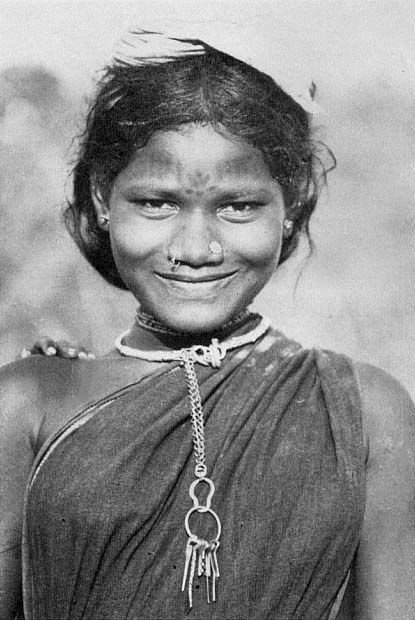
What a beautiful culture and history, but what leaves a mark on us is their ability to evolve and inspire. Along with that, their passion for innovation and cultural preservation that lies at their heart. For, in the world of Gond painting and its culture, we do not just find the reflection of its people, but what we can call a celebration of the boundless potential of the human spirit to create, inspire and transcends.


